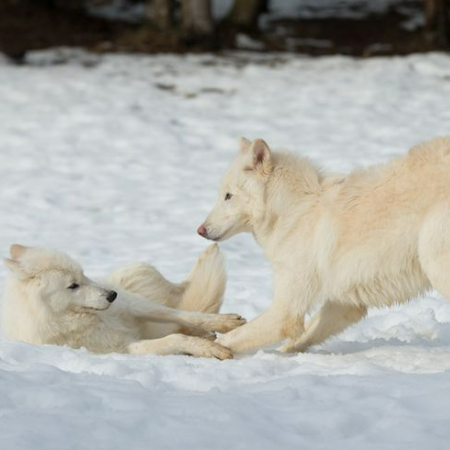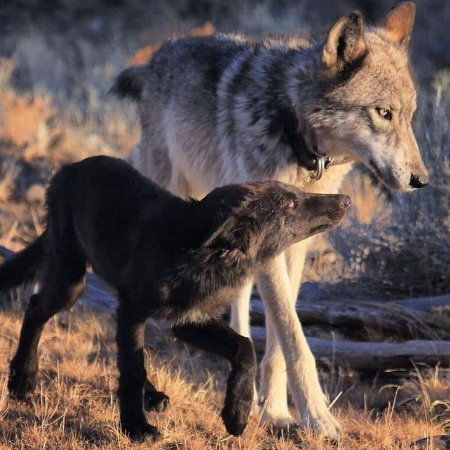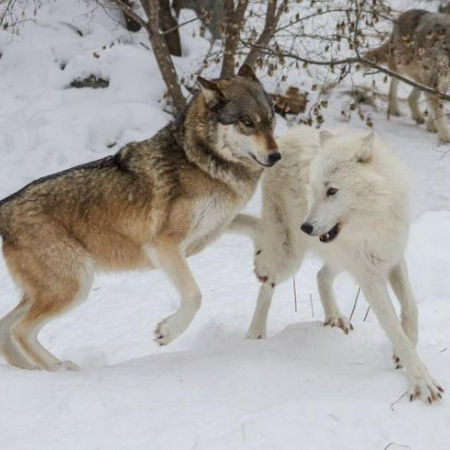“The Surprising Similarities Between Dogs and Wolves: Exploring Their Genetic Connection”
Ever wonder why your dog acts like a wild animal on occasion? It’s not all in your head! More often than not, dogs and wolves are similar.
Despite being distinct species, they share an intriguing genetic connection that influences a wide range of behavioral behaviors. Let’s examine the many unexpected similarities between these two species!
A Shared Family Tree
Let us start by discussing the family history. Canis lupus familiaris, the dog, and Canis lupus, the wolf, are related but distant cousins. Along with foxes, coyotes, and other creatures of a like nature, they are members of the Canidae family. Dogs that are domesticated have wild wolves as forebears. This implies that your fuzzy friend is actually a distant relative of the powerful wolf when you look at them.
Genetic Similarities
These commonalities are largely due to genetics. According to studies, 98% of the DNA in wolves and domestic dogs is the same. That’s quite a bit! Dogs and wolves are similar in appearance and behavior, which can be explained by their shared genetic heritage.

Both animals, for example, have very good hearing and smell senses. In the wild, wolves utilize these senses for communication and hunting, while dogs utilize them for daily tasks like spotting treats or detecting a doorbell from a great distance!
Social Structure and Communication
Pets have social tendencies in common with wolves as well. Each member of a pack has a specific duty, and packs are clearly hierarchical. Dogs regard the families they live with as members of their pack.
Just like wolves seek out their pack leaders, they also look to their owners for direction and leadership. In order to communicate, both dogs and wolves use body language. Their manner of expressing emotion is a wagging tail for a dog or a submissive stance for a wolf.
They convey contentment, surrender, or even hostility with these signs. Consequently, when your dog rolls over to reveal its tummy to you, it’s not merely a cute gesture rather, it’s a display of trust and obedience, much like a wolf might do for its group.
Hunting and Play Behaviors
Has your dog ever shown an interest in fetch games? Its whimsical nature is essentially an homage to its untamed forebears. Since wolves are hunters, they frequently act out scenarios from their hunting experiences.
The abilities that young wolves will need for survival are practiced in this play. These hunting instincts have not disappeared from domestic dogs either.

Many dogs still like playing games that include chasing, fetching, or pouncing, even after they are no longer required to hunt for their food. Like with their wild cousins, they can keep themselves entertained and cognitively engaged with this play.
Physical Traits
There are some interesting parallels when comparing physical characteristics as well. Although dogs exist in a variety of sizes and shapes, both wolves and dogs share a powerful, muscular physical composition.
To aid them in covering great distances in the wild, wolves usually develop larger bodies and longer legs. Another intriguing feature is the coats of dogs.
Dogs and wolves share a similar underlying fur structure, despite the differences in color and pattern of their coats. A softer undercoat serves as insulation, and both have an outer layer that shields them from the weather.
Instincts and Intelligence
As highly intelligent animals, wolves and dogs are alike. Wolf intellect is used for problem-solving, hunting, and territorial navigation. Elevated intelligence is also demonstrated by domestic dogs. In addition to understanding human emotions, they are able to follow instructions and solve puzzles.
To illustrate how intelligent and adaptable dogs can be, consider how many canine breeds were created expressly for different roles like guarding, retrieving, or herding. Their wolves provided them with these qualities of intelligence and flexibility.
Emotional Connections
The emotional connection that wolves and dogs have with their pack members is among their most heartwarming commonalities. Canines have inherited the strong bonds that wolves have with their pack, which they have carried over into their interactions with people.
A dog is seeking more than simply warmth when it curls up with you. Like a wolf with its pack, it’s demonstrating love and devotion. Since dogs were domesticated from wolves and became human companions, thousands of years of evolution have resulted in this link.
Conservation and Care
The significance of conservation is further shown by knowing the relationship between canines and wolves. In their environments, wolves are apex predators that regulate animal populations and preserve natural equilibrium.

Our understanding of how to care for both domestic and wild animals can be improved by learning more about wolves. It serves as a reminder to dog owners of the wild ancestry that molds their animals and the value of protecting and conserving the natural habitats of their distant ancestors.
Conclusion
A monument to their shared past and the remarkable ways in which evolution has fashioned them, dogs and wolves have many similarities. We might be surprised to see how similar these two animals are, from their social behaviors and emotional attachments to their genetic structure.
Keep in mind that your dog is a creature with strong ties to the natural world the next time you play with it or watch it interact with others. Not only is your pet a companion, but they also serve as a conduit to the intriguing world of their wild ancestors since they possess a small portion of the wolf’s spirit.
Doglime for more dog-related information.










